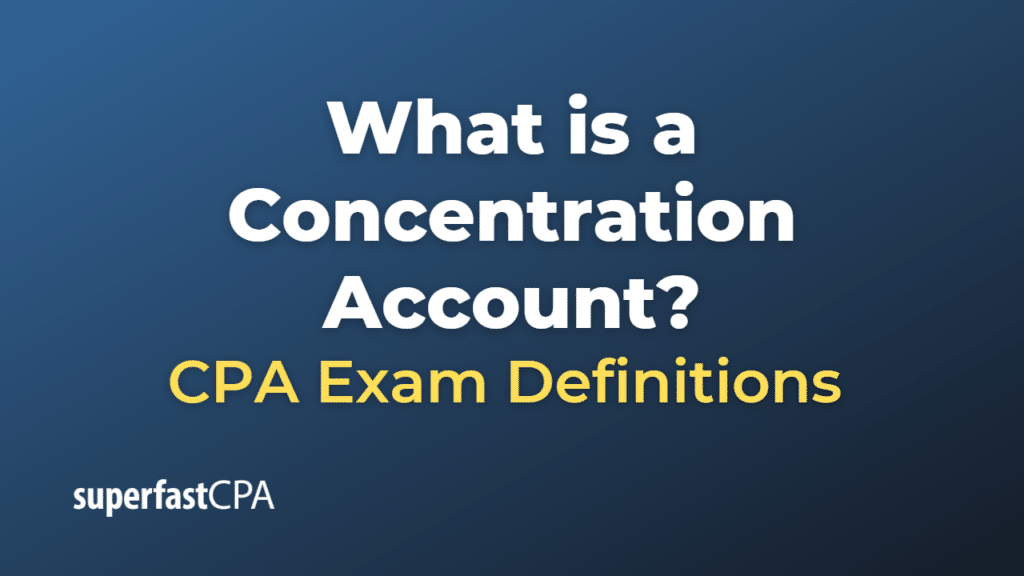Concentration Account
A concentration account, also known as a master account or a zero-balance account (ZBA), is a centralized bank account used by businesses or organizations to consolidate funds from multiple subsidiary accounts. The purpose of a concentration account is to improve cash management, streamline the reconciliation process, and optimize the use of available funds.
In a typical concentration account setup, subsidiary accounts (also called sub-accounts or child accounts) are created for various purposes, such as handling payments, receipts, or funds designated for specific departments or locations. At the end of each business day, or at a predetermined frequency, the balances of the subsidiary accounts are automatically transferred to the concentration account, leaving the subsidiary accounts with a zero balance.
The concentration account allows the business to:
- Centralize cash management: By consolidating funds from multiple accounts into a single account, the business can better monitor its cash position and make more informed decisions about cash deployment, investments, and financing.
- Streamline reconciliation: With all funds in a single account, reconciling account balances becomes simpler and more efficient.
- Optimize fund usage: By pooling funds in a concentration account, businesses can optimize their use of available cash, potentially reducing borrowing costs or increasing investment income.
- Minimize idle cash: Consolidating funds in a single account helps ensure that idle cash is minimized, enabling the business to put its resources to work more effectively.
- Enhance control and security: Centralizing cash management in a concentration account can help improve control over cash flows and reduce the risk of fraud or misuse of funds.
Concentration accounts are commonly used by large corporations, government entities, and non-profit organizations that have complex cash management requirements, multiple locations, or separate operating units. Banks and financial institutions provide various services and technologies to help businesses manage their concentration accounts and subsidiary accounts efficiently.
Example of a Concentration Account
Let’s consider a hypothetical example to illustrate how a concentration account works for a retail company with multiple store locations.
Suppose ABC Retail Corp operates five store locations, each with its own bank account for handling daily transactions like sales receipts and expense payments. To improve cash management and streamline account reconciliation, ABC Retail Corp decides to set up a concentration account at its bank.
The bank creates a concentration account (master account) and links each store’s bank account (subsidiary accounts) to it. At the end of each business day, the bank automatically transfers the balances in the subsidiary accounts to the concentration account, leaving the subsidiary accounts with a zero balance.
Here’s an example of the daily transactions and transfers for ABC Retail Corp:
Store 1:
- Sales receipts: $10,000
- Expense payments: $3,000
- Net transfer to concentration account: $7,000
Store 2:
- Sales receipts: $8,000
- Expense payments: $2,500
- Net transfer to concentration account: $5,500
Store 3:
- Sales receipts: $12,000
- Expense payments: $4,000
- Net transfer to concentration account: $8,000
Store 4:
- Sales receipts: $6,000
- Expense payments: $1,500
- Net transfer to concentration account: $4,500
Store 5:
- Sales receipts: $9,000
- Expense payments: $3,500
- Net transfer to concentration account: $5,500
At the end of the day, the concentration account balance becomes:
$7,000 + $5,500 + $8,000 + $4,500 + $5,500 = $30,500
With the concentration account in place, ABC Retail Corp can now monitor and manage its cash position more effectively. By consolidating the balances from all store locations into a single account, the company can make more informed decisions about cash deployment, investments, and financing. Additionally, the concentration account simplifies the reconciliation process, as all the funds are in one account, and helps the company optimize the use of available cash.













